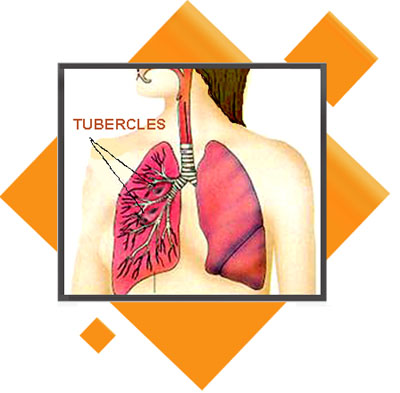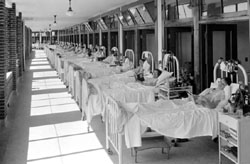Tuberculosis A High Contagious Respiratory Infection Tuberculosis (TB) is an infection caused by bacteria. Normally, tuberculosis does not show symptoms at first and takes months to develop.
In most cases, the immune system builds a wall around the TB bacteria in the lungs, transforming them into small hard tumors called “tubercles”, which, when calcified, remain in a latent state and do not progress. But in cases in which the immune system weakens, TB can be activated and become a serious disease. It normally attacks the lungs but it may affect other organs. When tuberculosis disease goes untreated, it progresses destroying major areas of the lungs and extending to other organs such as lymph nodes, bones and even the brain. Symptoms of active tuberculosis disease include a persistent cough, fever, night sweats, unexplained weight loss, weakness and, in more serious cases, coughing up blood. Tuberculosis History . Throughout the nineteenth and early twentieth centuries, tuberculosis was a disease that affected many Americans.Rapid urbanization had created poor living conditions for people who lived in American cities.Many cities had limited sanitation services, and apartment buildings, commonly known as tenements, had poor ventilation.Cities in Ohio and elsewhere were the breeding grounds for many diseases, including tuberculosis.The cramped living conditions meant that the disease would The large number of tuberculosis cases in the early twentieth century led many Ohio communities to build special sanitariums and "fresh air camps" for the treatment of patients with tuberculosis.As medical treatment improved and reform efforts improved conditions in inner cities in the twentieth century, tuberculosis became less and less common.Today, cases of tuberculosis are very rare in the United States. People at higher risk are children, the elderly and those with a weak immune system due to pregnancy or disease, as is the case with people who are HIV positive. Tuberculosis is not uncommon in the San Diego region. During 2006, there were 315 total cases of TB in San Diego County. California had the highest level of cases in 2005. HHS Continually Monitors Community Health Issues
• HOW IS TB DIAGNOSED? Through a simple skin test. A TB purified protein derivative is injected into the arm’s skin. If the skin responds with swelling greater to a specified size, then this indicates probable infection with TB bacteria. Normally a positive skin test does not mean the presence of active TB. Your doctor will examine X-rays of your lungs, ask you about any other symptoms and will try to make TB bacteria from a sputum (a fluid produced in the respiratory airways or the lungs) sample grow. These tests can take up to four weeks. It is difficult to diagnose active TB, especially in people with HIV because it can be mistaken for pneumonia, other lung problems or other infections. However, new and faster tests are being developed and a routine vaccine that is normally given is available. • HOW IS TB TREATED? If you are a carrier of TB, but have not developed thedisease, you should receive antibiotics treatment for at least 6 months or in combination with 1 or 2 other medications for 3 months. Active TB disease is treated with antibiotics. Since active TB disease bacteria can develop resistance to individual medications, it is treated with a combination of antibiotics. TB is difficult to cure and medication has to be taken for a minimum of 6 months. If treatment is interrupted, bacteria can develop resistance and the anti-TB medications will stop working. There are effective treatments to treat TB infection and active TB disease. If you have been exposed to TB, or have symptoms of TB, you should have a test done and receive treatment. The treatments for TB are long but they are the only option tu cure the disease. • REMEMBER: People with no medical provider or medical insurance can call the County’s Tuberculosis Control Program office at (619) 692-8621. .... Photograph date 1926- Location Waverly Hills Tuberculosis Sanatorium, off Dixie Highway in southwest Jefferson County. |
|
About Us | Privacy Policy | Disclaimer | Contact Us TEL. 619-427-4111 EMAIL: health@infooption.com Salud + Health Info is for information and educational purposes only. You should not rely on this information as a substitute for personal medical attention, diagnosis or hands-on treatment. If you are concerned abut your health or that of a child, please consult your family’s physician or health provider immediately and do not try and diagnose yourself. Copyright © 2001-2008 Info Option Network |
|
| |
 info
info
 spread rapidly, affecting many who lived nearby.Tuberculosis is a disease that affects the lungs.As the disease progresses, it becomes more and more difficult for the victims to breathe.People who worked in factories with poor air quality were even more susceptible to respiratory diseases like tuberculosis.Many of the people who were infected could not afford medical care, making the problem even greater.
spread rapidly, affecting many who lived nearby.Tuberculosis is a disease that affects the lungs.As the disease progresses, it becomes more and more difficult for the victims to breathe.People who worked in factories with poor air quality were even more susceptible to respiratory diseases like tuberculosis.Many of the people who were infected could not afford medical care, making the problem even greater.